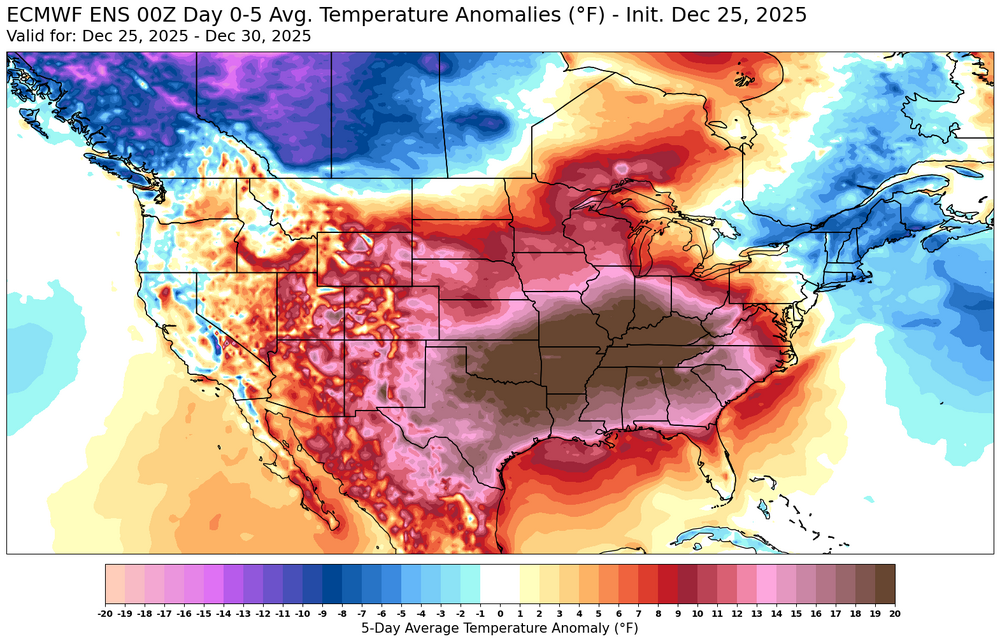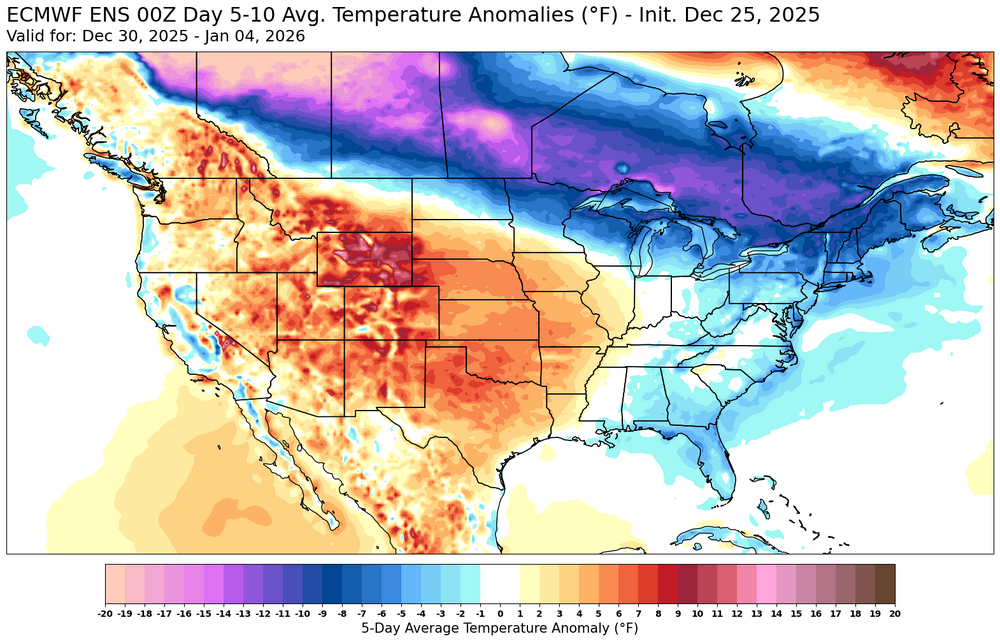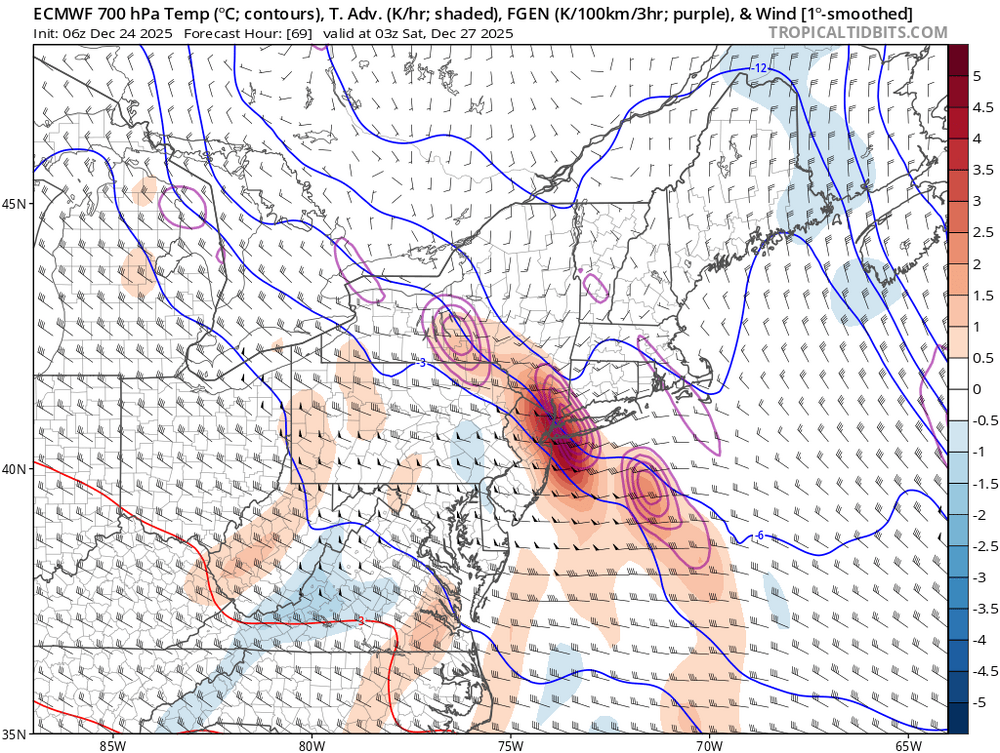-
Posts
36,050 -
Joined
-
Last visited
Content Type
Profiles
Blogs
Forums
American Weather
Media Demo
Store
Gallery
Everything posted by bluewave
-
Models not quite as cold for the end of December and the start of January as prior runs with the core of the cold now forecast to stay to our north. New run Old run
-
-
This season is going to be an interesting case study for snowy La Niña Decembers across the NYC Metro region and the rest of the season. With the storm coming in next few days, December 2025 will rank in our snowier La Niña December list of years. Most of the time these seasons got to 25”+ from Newark out to Islip. But the way we are getting this snowy December is different from the past La Niña cases. Unusually early stratospheric disruption with the record low sea ice in the Kara and Barents. The forecast is calling for a reversal of this pattern in the stratosphere after the first week of January. So it will be interesting to see if we follow up later in the season with more snow getting us over the 25” mark from Newark out to Islip. My guess is that we would probably need at least one NESIS KU event with a rapidly deepening low near the benchmark to pull this off. Since we haven’t reached 25”+ without at least one KU NESIS storm in the last 30 years. But this storm track has been inactive since January 2022 with all our snow this December coming with an unusually snowy clipper snowfall pattern that we haven’t seen in many years. The overall 500 mb pattern leading to this is quite unique for December. It doesn’t match previous Decembers. So with all the unusual influences this month, it’s difficult to say for sure we will repeat the past winter snowfall outcomes following snowy La Niña Decembers. But we can say for sure that December 2025 will go into the books as one of the our coldest and snowiest in a long time regardless of what happens after the first week of January.
-
The Euro is showing this coming in as a wall of heavy snow scenario where the best spots for banding can pick up 3-6” of snow in 3-4 hours with excellent rates.
-
The ensemble mean forecasts always kept the warmest to our SW which isn’t a surprise. But the 26th through the end of the month will verify several degrees colder. It’s the first week of January which will turn out to be the greatest model error from the long range. The warm up during the 17th to the 25th did beat expectations on the warmest few days which has been a common occurrence since 2011 and even prior to that. The -NAO is actually linking up with the Southeast Ridge this weekend which wasn’t originally forecast. You can see how much the models changed for Saturday from the earlier runs. But the cold high over New England is leading to a colder and snowier solution for a change. The last few years when this happened featured warmer storm tracks due to the lack of a cold high over New England. New run more -NAO linkage with Southeast ridge for rare favorable solution Old run Southeast ridge and -NAO separate
-
If it wasn’t for the strong -NAO, then record ridge across the Southern Plains would have expanded closer to our area.
-
Same with the GEFS and GEPS. I posted this in the main ENSO thread. In order to get really cold these days we need some kind of record warmth in the Arctic. If we can just get the storm track to shift south to a benchmark position in January, then maybe this can be our bounce back snowfall year which we have been hoping for.
-
While the week 2 forecasts have been running too cold from all the ensembles, the first week of January may be the coldest shift of them all so far. New run Old run
-
They do a pretty good job and also stream on YouTube if not included in some cable packages. The various weather channels going to other programming reminds me of MTV getting away from their core music video business and going to mostly reality shows.
-
This is the first time in a while that the 11-15 day ensembles have had this much of a warm bias in the East. https://frontierweather.dtn.com/verification.html
-
Probably related to the complexity of modeling long range interactions between the stratosphere and troposphere. My guess is that this was linked to the record low sea ice Kara and Barents seas. Very intersting paper below matches the current patterns around the Northern Hemisphere. https://iopscience.iop.org/article/10.1088/1748-9326/abc215 LETTER • THE FOLLOWING ARTICLE IS OPEN ACCESS North American cold events following sudden stratospheric warming in the presence of low Barents-Kara Sea sea ice Abstract While the relationship between the Arctic sea ice loss and midlatitude winter climate has been well discussed, especially on the seasonal mean scale, it remains unclear whether the Arctic sea ice condition affects the predictability of North American cold weather on the subseasonal time scale. Here we find that, in the presence of low Barents-Kara Sea (BKS) sea ice, sudden stratospheric warmings (SSWs) can favor surface cold spells over North America at the subseasonal timescale based on observations and model experiments. A persistent ridge of wave-2 pattern emerges over the Bering Sea-Gulf of Alaska several weeks after the SSW onset, with a coherent structure from the stratosphere to the surface, which, in turn, is conducive to synoptic cold air outbreaks in Canada and midwestern USA. This highlights a planetary wave pathway relating to BKS sea ice changes, by which the stratospheric polar vortex impacts the regional surface temperature on the subseasonal scale. In contrast, this mechanism does not occur with positive BKS sea ice anomaly. These findings help to improve the subseasonal predictability over North America, especially under the background of rapid change of Arctic sea ice in a warming world.
-
We have a shot at our first single digits of the season in early January near the coast.
-
We would have to go back to the 1970s or 1980s to get close to 25” from Newark out to Islip without at least a cat 1 NESIS KU event. This pattern is very unusual in that we are getting a strong ridge across the CONUS and a strong -NAO at the same time. So the Northern Stream is active for both rain like we saw last Friday and snow with the clipper before that. Have my doubts that we could get to 25” just on snowy clippers alone alternating with warmer storms and more rain or mix. I think it’s going to take a KU NESIS event to get us over the finish line.
-
We haven’t seen a clipper pattern like this in a long time. I am wondering if the benchmark KU track can become activated again at some point in January or February? That’s what we would need to get back closer to mid 20s seasonal snowfall.
-
Extreme temperature gradients in Asia and North America with multiple 4 to 5 sd jet streaks. Overall, the Northern Hemisphere is very warm for this time of year due to the warmth covering more real estate. So it will be hard to trust individual model storm details beyond 72-96 hrs. Since a tiny shift in the gradient between the strong 500 mb mid and high latitude blocking ridges can cause a big swing in local sensible weather. It’s looking like a very active pattern with the details to be worked out in the short term.
-
It will be interesting to see how well the Qubitcast does. https://www.artemis.bm/news/planette-develops-qubitcast-to-detect-severe-weather-events-up-to-six-months-in-advance/
-
The issues began when the NWS left NYC back in 1993. The trees over grew the site and the temperatures started running cooler than the other stations. Then the snowfall began to regularly get under measured. This is why I have been leaning more on using EWR and LGA for snow and temperatures. There was some interest from the media over 20 years ago on the topic. More recently there was a crew that measured about 1” more last week and Sam Champion measured about 1” higher with another event in recent years. I calculated that if the trees didn’t over grow the site, that NYC would have closer to 28 to 29 days reaching 90° each year on average since 2010 instead of the reported 17 to 18 days. The under measurement for snowfall isn’t as great as the temperatures. The NYC snowfall average last 7 seasons is only -1.1” under LGA and -2.4” below Newark. So anyone using NYC for temperature and snowfall contests should consider switching to LGA and EWR. Central Park Weather: Vegetative Overgrowth Affecting Weather Readings - WABC-TV (New York-WABC, August 22, 2003) - Forecasting the weather is not easy. Government equipment can often be blamed for giving faulty weather information. As Bill Evans explains, a big culprit may be some of the equipment buried in Central Park. Rainfall, snowfall, and the temperature are all vital information recorded 24 hours a day at the weather station located in the heart of Central Park. But meteorologists like Michael Schlacter have serious concerns about the accuracy of the stations data. It sits amid overgrown vegetation and he says thats the problem. The leaves can trigger snow gauges and trees can warp rain and wind measurements. On this hot day, a temperature gauge is in the shade instead of direct sunlight. Michael Schlacter, Weather 2000: "Its kind of like driving a car without a speedometer, odometer, and gas gauge. You are running with false information." The weather instruments at Belvedere Castle have long adorned the top. There used to be a government meteorologist here in the city to keep an eye on them. But now the nearest meteorologist is 60 miles that way. But National Weather Service meteorologists say they knew the weather readings in the park would never be as keenly accurate as the ones at the airports where guidelines prevent foliage from being within 100 feet of the station. Schlacter: "We knew that at times we would have flaky readings, that leaves would fall in gauges, that we would have problems with visibility sensors." [NWS Meteorologist-in-Charge Michael] Wyllie says the weather station is there because it was historically significant to maintain its presence in the park. He says theres been a lot of growth because of the wet spring at so much in fact that temperatures have routinely been recorded lower in the park than at the airports. Wyllie: "We are actually having a micro climate system there because of the vegetation." Imperfect perhaps but nonetheless the system provides the official record of weather for the country's largest city. And Michael Schlacter says its a city that deserves better. Schlacter: "I think New Yorkers deserve a lot better, and I think they deserve the best weather station money can buy." Copyright 2003 ABC Inc., WABC-TV Inc.
-
This is one of the most extreme December patterns that we have experienced in terms of temperature and precipitation volatility across the CONUS.
-
Made it to 49° here with the MOS and raw guidance forecast for low 40s. Noticed the MOS from several days ago was around 50° but it shifted colder. Models often underestimate highs with sunny and windy downslope flow and the cold air lagging frontal passage.
-
Big guidance beat today with some spots sneaking in a 50° high so far. MacArthur/ISP PTSUNNY 50 21 32 W18G29












